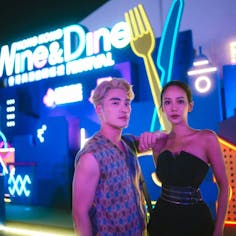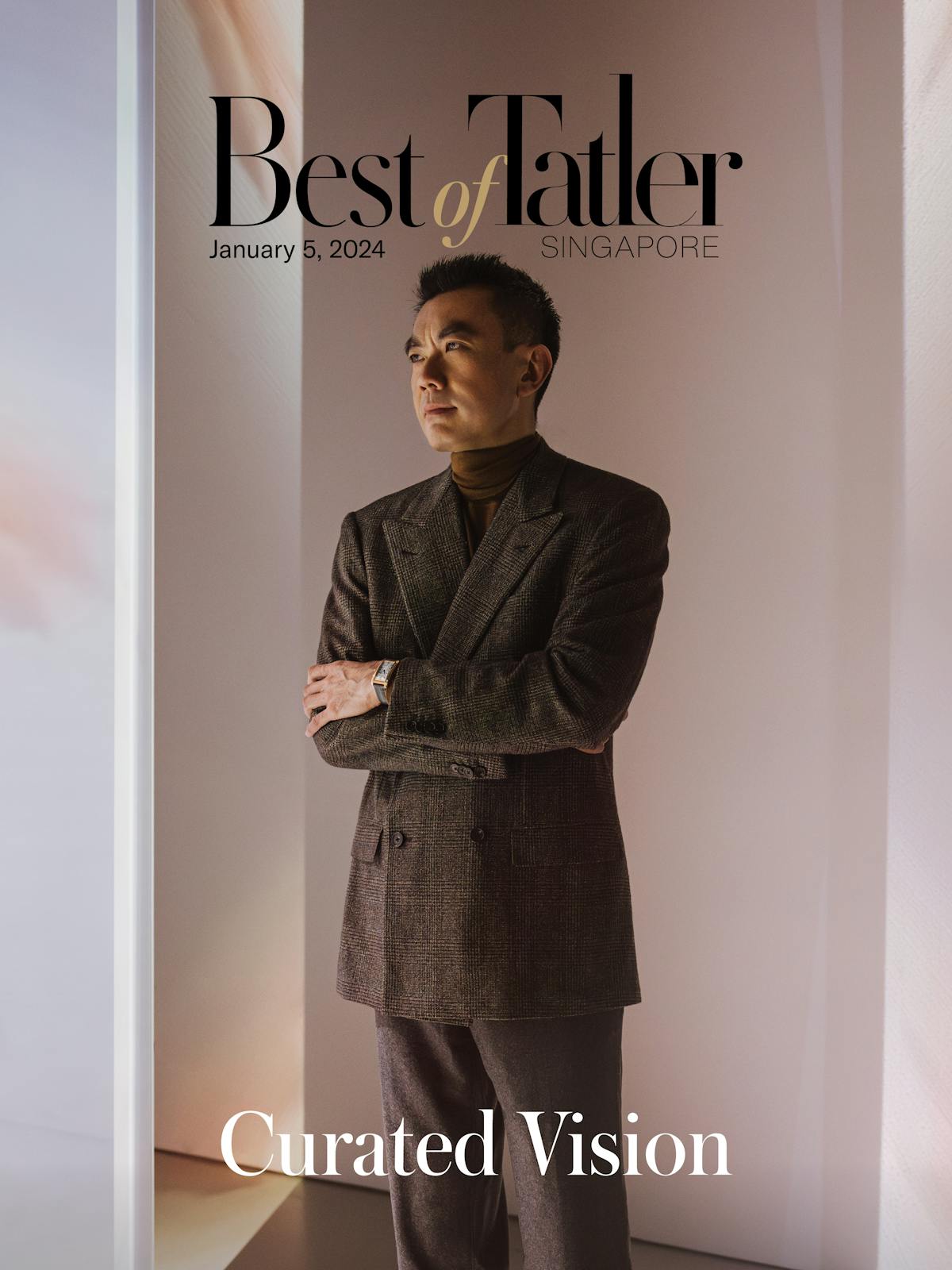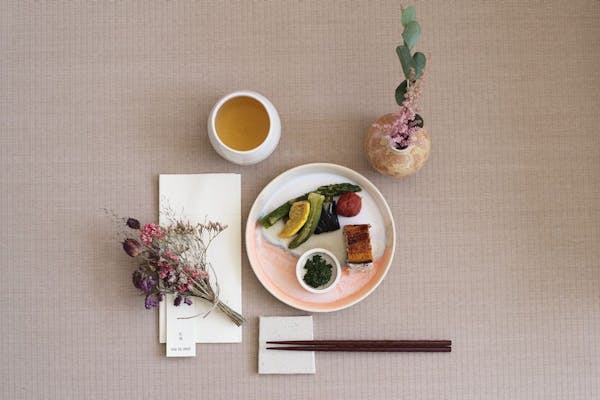In The Hot Seat With Eugene Tan
The first thing that catches our eye when we step inside Eugene Tan’s office at the National Gallery Singapore is the sheer number of art and design books on his desk. With several towering stacks, it looks as if the museum’s director is surrounded by a fort as he works in front of the computer. As he gestures for us to take a seat at the other side of the large wooden table cleared of books, we catch sight of a framed text‐based print on the floor, leaning against a wooden bookshelf filled from floor to ceiling with even more books. It is a work by Singapore‐based artist Heman Chong (who coincidentally explores elements of literature in his practice), created as a “publicity poster” for the opening of a fictitious franchise of the famous Guggenheim museum chain in neighbouring Johor Bahru, Malaysia. The copy, in red capital letters, reads: “Just because museum directors in Singapore are so f ***ing ridiculously boring to talk to, much less hang out with”.
Such tongue‐in‐cheek social commentary is typical of Chong’s art, but this particularly acerbic one titled Obscenely Bad Guggenheim Joke #4 is targeted at those running Singapore’s cultural spaces, so much so that a Johor Guggenheim would be less boring than having one here. The sentiment of the work aside, we ask Tan if he is boring to talk to. “Absolutely. I’m not a very interesting person,” comes his self‐deprecating reply. “To be fair, he (Chong) made the work in 2011, before I became a museum director,” he adds.
But “boring” is hardly a word we would use to describe the man who is at the helm of two of the most important art museums in our city: the National Gallery Singapore and the Singapore Art Museum (SAM). “Shy” or “reserved” (“I’ve been described as such,” Tan lets on) might be more apt, considering how Tan has been elusive to Tatler despite our persistent requests to do a profile feature on him over the years, preferring instead to let the museum curators take the spotlight when it comes to talking about their work.
Now that we have him in the hot seat, we discover a man who is so passionate about art that all of the different roles he has taken on within the visual arts ecosystem throughout his career, be it in Singapore or abroad, have “always [been] about how I could contribute to the [art] scene or the ecology [in Singapore]”—and in no small part, helping Singapore’s visual arts scene flourish, in an era that is different from what Chong perceived it to be all those years ago.
Tan became the director of National Gallery Singapore in 2013, two years before it opened its doors to the public in 2015. Under his leadership, the gallery embarked on an ambitious exhibitions programme, including partnerships with international museums such as Centre Pompidou, Paris, the National Museum of Modern and Contemporary Art, Korea (MMCA) and the National Museum of Modern Art, Tokyo (Momat).
Some of the important exhibitions that have “defined the identity of our museum in rewriting our own art history” include Reframing Modernism: Painting from Southeast Asia, Europe and Beyond, the gallery’s first international collaboration, held in 2016 and organised with Centre Pompidou, Paris, that shifted the existing paradigm of how modernist painting is understood.
It was in London, while studying for his Bachelor of Science in economics and politics at Queen Mary College, University of London, that Tan first became interested in art. His campus was situated in the East End of London, close to the art gallery Whitechapel Gallery, which he would pass by every day on the bus.
His interest in art further developed throughout the 15 years he spent in the UK, where he also did his Masters of Arts in post‐war and contemporary art at Sotheby’s Institute of Art – London. It was during this time that he started writing art criticism for art magazines. He later worked in a gallery in London for a year, where he curated small exhibitions, before pursuing a PhD in art history from the University of Manchester. By end‐2003, he landed his first job in art back in Singapore as director of the then‐Earl Lu Gallery (later renamed the Institute of Contemporary Arts Singapore), which is the curatorial division of the Lasalle College of the Arts. He was also appointed a co‐curator of the inaugural Singapore Biennale in 2006 and the curator for the Singapore Pavilion at the 2005 Venice Biennale.
With a career in the visual arts that started in the contemporary, it was no surprise when Tan was asked to also oversee SAM in 2019. With its two buildings on Bras Basah Road and Queen Street currently closed for a major building revamp, SAM currently operates out of its pop‐up contemporary art space at Tanjong Pagar Distripark, which opened in 2022.
“I want people to think of Singapore whenever they think of the top museums in the world. If someone asks you, ‘what do you think are the top museums in the world’: there’s The Metropolitan Museum of Art, the Museum of Modern Art, and there’s also the National Gallery Singapore and [the] Singapore Art Museum,” Tan enthuses. “That’s my aim for the two museums.”
Read the story here.
DINING
New restaurants and bars to visit in Singapore this January 2024
We’re starting the new year right with January’s crop of new bars and restaurants to explore and challenge our taste buds. At Entrepôt, for instance, Anglo-Asian cuisine takes the spotlight, while modern French fine dining reigns at Roia, tucked within the Singapore Botanic Gardens. Also situated amidst lush foliage is Air, a new restaurant and circular campus on Dempsey Hill centred on unpretentious food guided by sustainable principles. Helmed by chefs Will Goldfarb and Matthew Orlando, founder of Amass in Copenhagen, look forward to maximum flavour, achieved using sustainable practices and techniques, including pressure-cooking fish bones to make into noodles, which are served alongside a creatively presented whole coral grouper.
The rise of casual offshoots of more renowned establishments is still on the rise, especially with Fireplace by Bedrock and Ginkyō by Kinki, both of which have found a home at One Holland Village. Lovers of steak will also love Liberty, a new South American barbecue restaurant with Asian accents. With a menu crafted by chefs Yong Soo-Do and Chris Tuthill, anticipate delights such as char siu pork belly and kalbi short rib, alongside cocktails like the “Roaring Pink Dragon”, a refreshing concoction of rum, mango, pink dragon fruit, lime, and mint.
Those in the East Coast head down to the newly opened Jypsy Parkland Green. With an outlet-exclusive brunch menu including highlights like the salmon egg benedict, Wagyu hamburger steak plate and a tamago sando, this is the right spot for beachgoers, families, and joggers on a break.
This month, there’s also no shortage of watering holes for the discerning imbiber. Side Door is a gastro-bar with hearty dishes and South Korean-inspired tipples, while Close Shave, an extension of beloved barber Sultans of Shave, offers seductive cocktails and slick haircuts. To transport yourself to 1980s Hong Kong, head down to Cha Chaan Teng for bar bites and cocktails with familiar flavours. For example, the “Sap Saam Mui”, where burnt claypot rice and lap cheong are unlikely bedfellows to gin, campari, and dry vermouth.
Make sure to hit High House too, the new nightlife destination on the 61st and 62nd floor of One Raffles Place. Here, sink your teeth into plates like lobster mac and cheese and Thai massaman curry with sakura pork belly before delving into the cocktails as the night progresses, like the “Sticky Mango Highball” inspired by the mango sticky rice, and the “Seaweed and Shiso” made with seaweed-infused Roku gin, shiso Baldonia dry, and umami bitters.
Read full story here.
HOMES
How a multidisciplinary design studio’s team bonding exercise turns into a bonafide ceramics brand
OWIU Goods’ forest glaze series of pottery captures the multifarious shades of the tree canopy, blending moss, olive, pine and sage into captivating gradients on the smooth surfaces of plates and matcha bowls. In contrast, the depths of the ocean inspired the contemplative, blackened dark coastal glaze.
These are some experiments by OWIU Goods. OWIU stands for Only Way Is Up. The brand was started by Joel Wong and Amanda Gunawan, who run the LA-based architecture and design studio OWIU Design. Some of the studio’s projects include the tranquil backyard of celebrity couple Henry Golding and Liv Lo in Los Angeles, as well as F&B spots such as Goho Kaiseki & Bar, Mezcla and Ms. Maria & Mr. Singh in Singapore.
The duo and their staff make the ceramics in their office in Los Angeles. Gunawan shares how they are constantly trying out new things all the time, such as new glazes. She continues: “We’ve recently started harvesting our local clay from California, driving out of the city with spades and digging up our own clay. We bring them back to our studio to process them and then use them to make some of our items. We’ve also experimented with crushing rocks, mixing them into different clays, and then firing at different temperatures to see the results.”
Retailed in LA and online, OWIU Goods’ fans include fashion entrepreneur Aimee Song, who customised a set for her new home in Los Angeles. This year, the brand extended its presence to Japan with five pop-ups in Tokyo–two at Parker Café and three at Isetan Shinjuku.
With so much going on, Gunawan continues to look ahead. She says: “We will also be releasing a whole line of glazes inspired by our spring office trip to Japan. Next year, we will offer candles with scents that correspond to our landscapes and new items to our lines, such as smaller teacups and pasta bowls. On top of that, we are constantly working on exciting collaborations with brands that we love.”
Read full story here.
LIFESTYLE
Art SG returns for its second edition in January 2024
The inaugural edition of Art SG in January this year represented the beginning of a new chapter for the art scene in Singapore and Southeast Asia. “Apart from the content of the fair, it really is about the people, the experiences and the relationship‑building,” says fair director Shuyin Yang. “Art SG is designed to appeal to a wide range of audiences—and I think we delivered that with the first edition [of the fair].”
With a strong turnout of 43,000 visitors, the international event attracted art collectors and connoisseurs not just in Singapore, but also those from across Southeast Asia, the Asia‑Pacific region and beyond. “The strong curation of the fair and the high‑quality artworks presented by world‑renowned leading galleries, alongside the best of Singapore and Southeast Asian galleries, created this diversity of art, engaging with everyone from established collectors to new art buyers, as well as art lovers,” says Yang. “There’s also a real desire to see a good balance between internationally recognised names and fresh discoveries. The audience also responded well to new disciplines and emerging practices that offer a fresh perspective on how to view contemporary art and the world through the eyes of artists.”
When Art SG makes its return to Singapore this year, from January 19 to 21 (with a VIP preview on January 18) at the Sands Expo & Convention Centre in Marina Bay Sands, it will feature a line‑up of 115 galleries from 33 countries and territories. Some of the world’s best‑known galleries, including Gagosian, White Cube and Lehmann Maupin, will make their return to the fair, alongside regional stalwarts such as Yavuz Gallery, Richard Koh Fine Art and Sullivan+Strumpf. Joining them will be 38 new exhibitors, including Kaikai Kiki Gallery, which is helmed by famed Japanese artist Takashi Murakami.
While the Galleries, Focus and Futures sections remain a mainstay, along with a programme of large‑scale installations and insightful conversations as well as film and new media curations, the second edition of Art SG will also see city‑wide activations in collaboration with Singapore’s visual art museums, important private collections and cultural partners, all within Singapore Art Week, the city’s annual celebration of the visual arts. This is reflective of Art SG’s impact and resonance within the art ecosystem as well as its fostering of ideas, relationships and thought leadership.
Read full story here.
DISCOVER THESE ON TATLER ASIA
How Oculus Collective’s Eclipse series sets a new standard for sleek design.
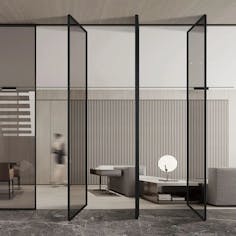
A new frontier: Standard Chartered’s insights on navigating the shifting landscape of private banking.

Rejuvenate your bathroom with these colourful washbasins from Villeroy & Boch.
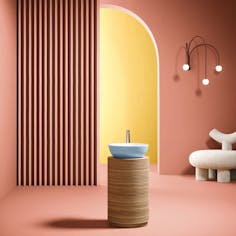
Love the Philippines: A tour through local heritage sites for discerning travellers.
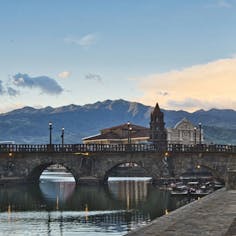
How Anthracyte Studio fashions a sense of poetic elegance in an office setting.
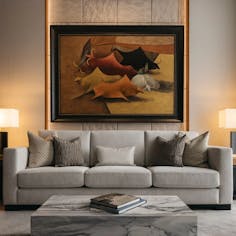
24 hours in Hong Kong: Fiona Xie and Loui Lim discover the city’s best culinary and cultural gems.
